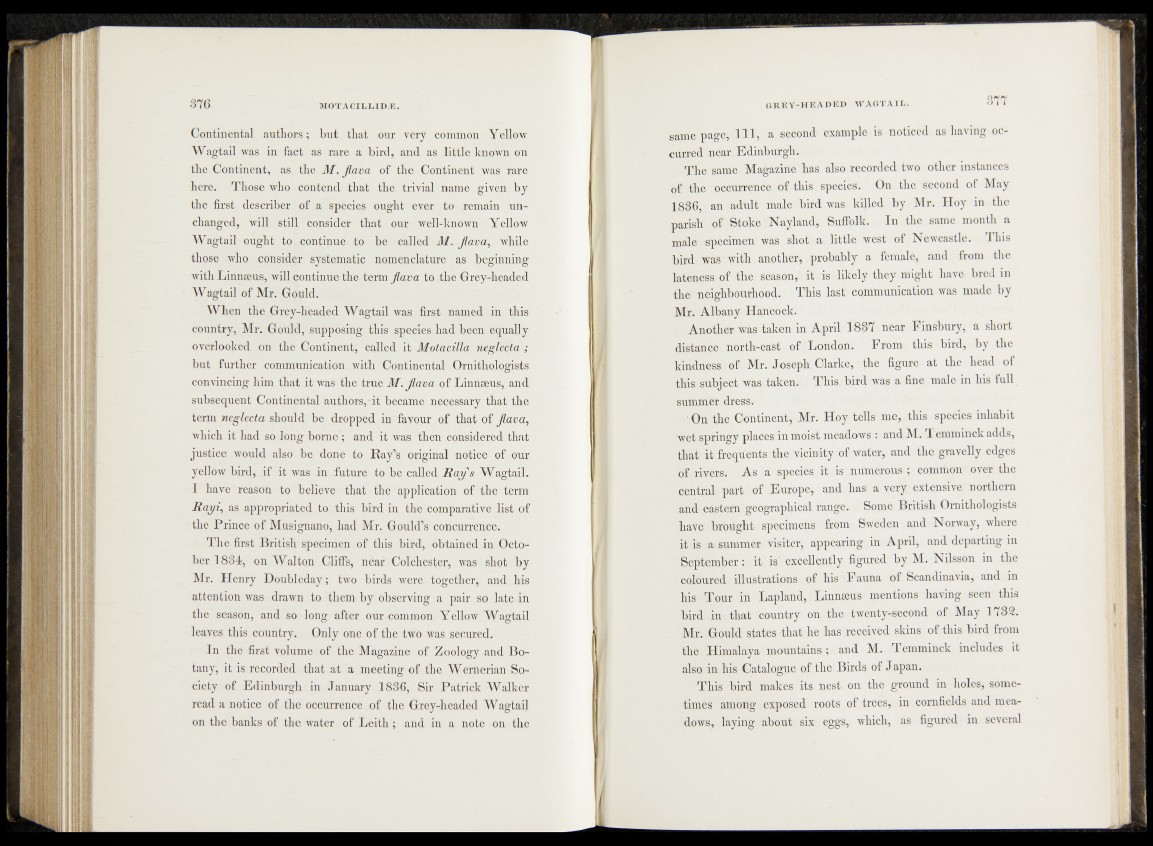
Continental authors; but that our very common Yellow
W agtail was in fact as rare a bird, and as little known on
the Continent, as the M. Jlava of the Continent was rare
here. Those who contend that the trivial name given by
the first describer of a species ought ever to remain unchanged,
will still consider that our well-known Yellow
Wagtail ought to continue to be called M. Jlava, while
those who consider systematic nomenclature as beginning
with Linnaeus, will continue the term Jlava to the Grey-headed
Wagtail of Mr. Gould.
When the Grey-headed Wagtail was first named in this
country, Mr. Gould, supposing this species had been equally
overlooked on the Continent, called it Motacilla neglecta ;
but further communication with Continental Ornithologists
convincing him that it was the true M. Jlava of Linnaeus, and
subsequent Continental authors,-it became necessary that the
term neglecta should be dropped in favour of that of Jlava,
which it had so long borne; and it was then considered that
justice would also be done to Ray’s original notice of our
yellow bird, if it was in future to be called R a y s Wagtail.
I have reason to believe that the application of the term
Rayi, as appropriated to this bird in the comparative list of
the Prince of Musignano, had Mr. Gould’s concurrence.
The first British specimen of this bird, obtained in October
1834, on Walton Cliffs, near Colchester, was shot by
Mr. Henry Doubleday; two birds were together, and his
attention was drawn to them by observing a pair so late in
the season, and so long after our common Yellow Wagtail
leaves this country. Only one of the two was secured.
In the first volume of the Magazine of Zoology and Botany,
it is recorded that at a meeting of the Wernerian Society
of Edinburgh in January 1836, Sir Patrick Walker
read a notice of the occurrence of the Grey-headed Wagtail
on the banks of the water of Leith ; and in a note on the
same page, 1 1 1 , a second example is noticed as having occurred
near Edinburgh.
The same Magazine has also recorded two other instances
of the occurrence of this species. On the second of May
1836, an adult male bird was killed by Mr. Hoy in the
parish of Stoke Nayland, Suffolk. In the same month a
male specimen was shot a little west of Newcastle. This
bird was with another, probably a female, and from the
lateness of the season, it is likely they might have bred in
the neighbourhood. This last cqmmunication was made by
Mr. Albany Hancock.
Another was taken in April 1887 near Finsbury, a short
distance north-east of London. From this bird, by the
kindness of Mr. Joseph Clarke, the figure at the head of
this subject was taken. This bird was a fine male in his full
summer dress.
On the Continent, Mr. Hoy tells me, this species inhabit
wet springy places in moist meadows • and M. T emminck adds,
that it frequents the vicinity of water, and the gravelly edges
of rivers. As a species it is numerous; common over the
central part of Europe, and has a very extensive northern
and eastern geographical range. Some British Ornithologists
have brought specimens from Sweden and Norway, where
it is a summer visiter, appearing in April, and departing in
September: it is excellently figured by M. Nilsson in the
coloured illustrations of his Fauna of Scandinavia, and in
his Tour in Lapland, Linnseus mentions having seen this
bird in that country on the twenty-second of May 1732.
Mr. Gould states that he has received skins of this bird from
the Himalaya mountains; and M. Temminck includes it
also in his Catalogue of the Birds of J apan.
This bird makes its nest on the ground in holes, sometimes
among exposed roots of trees, in cornfields and meadows,
laying about six eggs, which, as figured in several